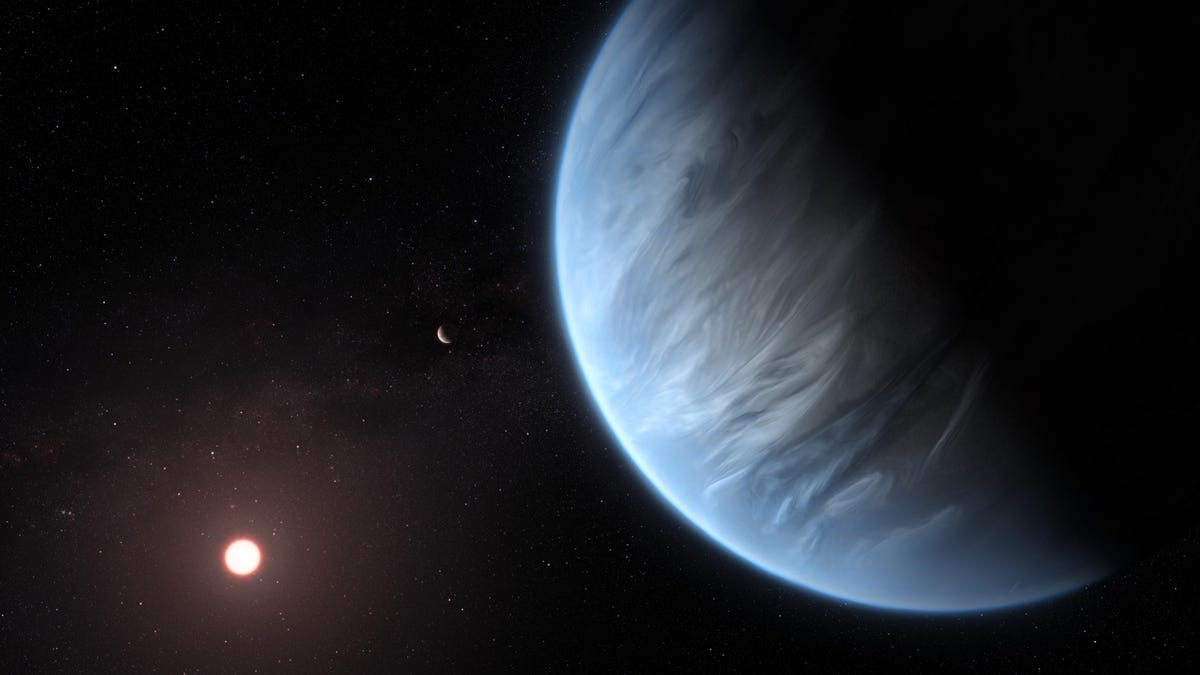Vapor found at potentially habitable planet: 'Possible this is a water world'
Water vapor spotted on Exoplanet K2-18b, an alien world where climate might be right for life.

An artist's impression shows K2-18b and its host star. The planet has life-friendly temperatures, and it may have water too.
For the first time, astronomers looking beyond our solar system have spotted water vapor in the atmosphere of a planet where temperatures might also be just right for life.
Exoplanet K2-18b is a super-Earth that's twice the size of our planet, with eight times the mass. It's also wet, or at least the skies around it are. Researchers found evidence of water vapor when they took data captured by NASA's Hubble Space Telescope in 2016 and 2017 and ran it through an open-source algorithm they developed to analyze distant planets. They published their findings Wednesday in the journal Nature.
Water vapor has been found in the atmospheres of other planets, but this is the first time such moisture has been spotted at a planet in the habitable zone of its star, where temperatures could be tolerable, if not downright pleasant.
More data is needed to determine what kind of cloud coverage the planet has, how much water is present in the atmosphere and if the stuff is actually forming big bodies of water on the planet's surface like here on Earth.
"It's entirely possible this is a water world," said co-author Giovanna Tinetti, a professor of astrophysics at University College London. But she cautioned that it's too early to confirm the presence of some sort of surface ocean.
It's estimated that temperatures on the planet could be between about minus 100 degrees Fahrenheit (minus 73 Celsius) and 150 Fahrenheit (66 Celsius). That's a big range, of course, but it's not too far off from the conditions we see here on Earth.
"However, this planet is not a second Earth," Angelos Tsiaras, a research associate at UCL, told reporters Tuesday. "It is orbiting what we call a red dwarf star ... in this environment the space weather is more hostile than here on Earth."
Red dwarf stars, also called M-dwarf stars, are smaller, cooler and dimmer than our sun. They're also known for frequently releasing powerful solar flares that could threaten to irradiate orbiting planets. Fortunately, K2-18, which is 110 light years from Earth, isn't as prone to spouting off as other M-dwarf stars.
"This one in particular is not very active at all," Ingo Waldmann, a lecturer in extrasolar planets at UCL and the paper's co-author, told me. "We've not seen any flaring."
The analysis of the starlight passing through the planet's atmosphere also showed hydrogen and helium. Future studies could determine if other molecules closely connected with life as we know it, like nitrogen and methane, are also present.
The researchers are hopeful that the upcoming James Webb Telescope, which'll be significantly more powerful than Hubble, may provide an even clearer view of what's happening on distant exoplanets. If conditions are right, you may even want to add K2-18b to an interstellar travel itinerary in the far-off future.
"Our discovery makes K2-18b one of the most interesting targets for future study," Tinetti said.
Originally published Sept. 11, 10 a.m. PT.

